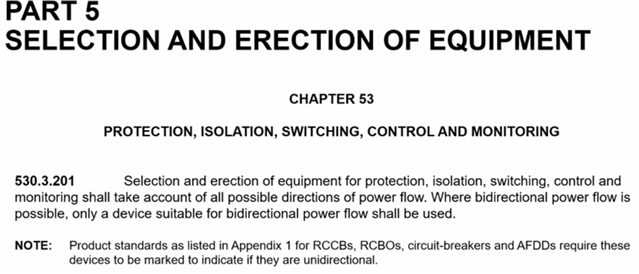I had an email this morning from the IET telling me that a Draft for Public Consultation has been published for Amendment 3 to BS 7671.
Details here electrical.theiet.org/.../
JP
I had an email this morning from the IET telling me that a Draft for Public Consultation has been published for Amendment 3 to BS 7671.
Details here electrical.theiet.org/.../
JP
Just based on Mark Cole's video....


OK, I'm confused already (I know, with me it's easily done...)
First thought - does this cover my simple PV system? In the grand scheme of things power only flows one way - backwards - from the Inverter to the CU. So not bi-directional? At a more detailed level the inverter does draw a little power overnight (just to keep the grid fail monitoring and general logging going) - would such tiny amounts (<1W from memory) count as making it bi-directional?
Second thought was for inductive (or indeed capacitive) loads - with a power factor other than unity (1.0) - if I've understood AC theory correctly, some power flows backwards during part of each cycle (hence the difference between W and VA, or the so-called "wattless current") - so is it allowable to add up instantaneous power over a period (allowing some backward power to be cancelled out) before deciding whether the overall power flow is bi-directional or not? if so, how long? A single cycle, or perhaps longer - e.g. would a machine that mostly drew power, but occasionally used say re-generative breaking to push waste power back into the grid, count?
Maybe I've missed something somewhere (or forgotten what I already knew - that seems to happen more often these days) - but what are the physical effects we're trying to avoid with all this? If it's purely down to power flow it presumably doesn't matter if voltage is left on the "load" terminals when the device is open (otherwise we'd have caveats for devices connected in parallel or back-feed situations), and normal current flows in both directions anyway (on each half cycle), so nothing can be polarity sensitive in the conventional sense (like semiconductors) or the way an arc breaks.. . or can it?
- Andy.
.Ah, something's returning... . was it something to do with the way T buttons are wired? Make the wrong assumptions and the test circuit connects the supposedly dead side to the supply with the device open and the button pressed?
Hi Andy
There are several things it tries to address.
Power on the load side of a circuit could burn out the circuitry of lets say an RCBO as it in effect has an inwards side and an outwards side. ie Supply and Load
Also circuits back feeding onto the grid from micro generation like Solar PV or Car2Grid (other names are available)
Hi Andy
There are several things it tries to address.
Power on the load side of a circuit could burn out the circuitry of lets say an RCBO as it in effect has an inwards side and an outwards side. ie Supply and Load
Also circuits back feeding onto the grid from micro generation like Solar PV or Car2Grid (other names are available)
We're about to take you to the IET registration website. Don't worry though, you'll be sent straight back to the community after completing the registration.
Continue to the IET registration site